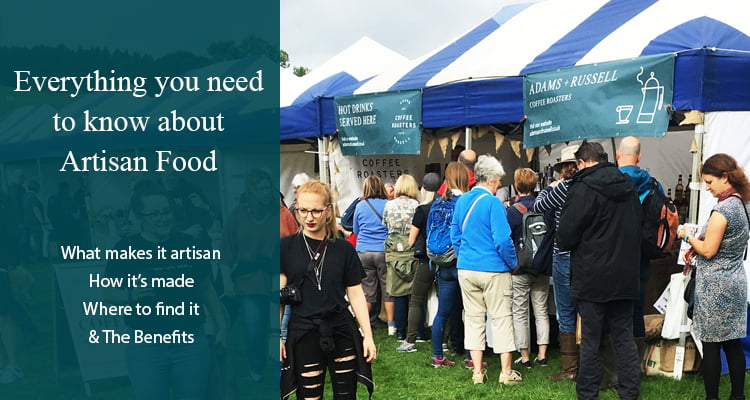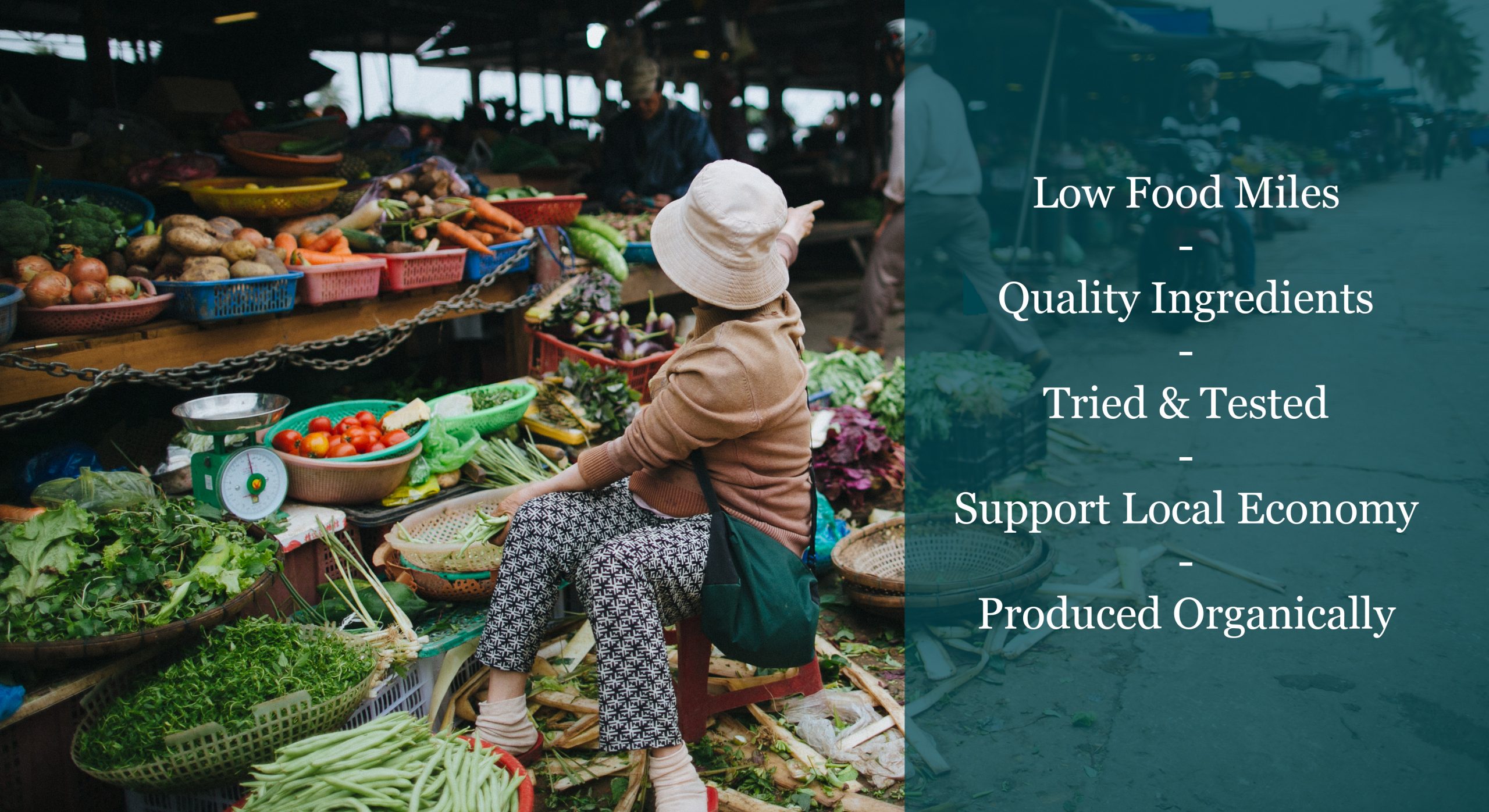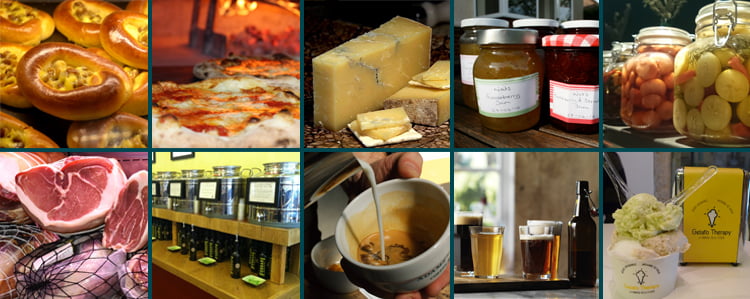

In recent years artisan food and beverages have grown increasingly popular.
Consumers are looking for interesting food that has clear provenance (i.e. we know exactly where it came from). Produced using traditional, organic, sustainable and locally-based methods.
In this in-depth article we take a look at the artisan food and drink industry and answer some key questions such as:
- What is the difference between artisanal food and normal food? What does it really mean to be an artisan product?
- What do artisans do?
- How do you identify an artisan product?
- How do you become an artisan producer?
- Where is the industry going?
Let’s dive in!
What makes an artisan product?
Have you ever wondered where artisan bread or cheese comes from? How did this whole movement start in the first place?
Well, in truth this type of product is simply one that is made in a traditional manner. Often an alternative name will be used like traditional, farmhouse, natural or heritage.
Countries, regions and industries will classify and consider artisan products differently. But, in general, this type of product usually meets one or more of the following criteria:
- It is produced on a small-scale or in small batches. It isn’t mass-produced or farmed on an industrial scale.
- It is made using traditional methods and tools – usually being hand-crafted as opposed to industrially made.
- It is created according to a traditional recipe that may have been around for hundreds of years. Meaning there are very few, if any, modern ingredients. Like preservatives, colourants, sweeteners, thickeners or other chemicals.
- It is made locally, not imported from another country (though this depends on where the distributor or shop for the product is based).
- It is traceable or is made from traceable ingredients. Establishing provenance is a key aspect of artisan food.
These aren’t hard and fast rules, however. In practice it can be difficult to find out all this information about an individual product.
A bread roll in a restaurant might be described as ‘artisan’ because it is baked in a traditional manner – but the flour and other ingredients it contains could be mass-produced.
It is tricky to know exactly, and to what extent, an individual product is artisanal. But the ingredients and production methods will usually lead to many benefits.
The benefits of artisan products

We think of artisans as skilled craftsmen and women who have mastered a particular skill or process. The artisan doesn’t create something because it is their job – they do it because they love and value the process and the end product.
This message carries over into food. Rightly or wrongly artisanal products are perceived to have a higher quality than mass-produced alternatives.
Whether this is true or not depends on each individual product, but there are some common reasons why artisan drinks and food items have an edge:
- Low ‘food miles’ – produce and ingredients are usually sourced locally and don’t travel far to the point of purchase. This results in lower transport emissions, fresher produce and less need for preservatives or transporting conditions that could affect the taste and texture (such as extended freezing).
- Quality ingredients – while the end products of an artisan process are usually excellent quality due to the care put into their creation, the basic ingredients they use are also very important. And this is what makes the industry so interesting. A pizza might be artisanal because it is cooked in a traditional wood-fired oven – but another pizza might be cooked the same way and use artisanal flour for the dough. Is one more artisan than the other? Does it even matter? That’s up to the consumer to decide!
- Tried and tested production – the processes used by food artisans are traditional techniques that have worked for many years. Although modern ingredients and technology can make food faster and at a lower cost, you can be sure that anything made by an artisan will be the result of proven techniques that have shown to get great results.
- Support the local economy and independent businesses – the vast majority of artisan producers selling products in any town will be based nearby and/or will be an independent company. Buying these products helps support these companies and keep diversity in the marketplace.
- Organic production – they often use more organic ingredients and growing techniques that are in-keeping with traditional practices. There is more on organic food below, but this is undoubtedly perceived to be a great benefit to a growing number of consumers.
- Food with meaning – these products can often have a deep connection to a certain place, ingredient or process. Artisans might use techniques passed down in a region for hundreds of years, or they might be the last producers in the world to work with a particular ingredient in a traditional way. These stories give the products meaning and importance that you won’t get in a giant supermarket aisle.
- Unique flavours, textures, combinations and ideas – ultimately, artisan products can only be successful if they taste good, and this is another area where the approach brings interesting benefits. Mass produced food is limited by the most efficient production techniques and cheapest, most available ingredients. An artisan has more freedom to experiment and try new things without having to reset big moving production lines.
Types of artisan product

Now we know a bit more about what being an artisan product actually means, let’s take a look at the different types available.
Artisan beverages and food items come in many forms, here are some of the most popular and common categories, along with the key features that usually distinguish each product’s artisanal pedigree:
- Bread and baked goods – made with traditional baking techniques, equipment and ingredients.
- Pizza – cooked using old-fashioned methods such as wood-fired outdoor ovens, and featuring artisanal toppings.
- Cheese – produced by hand with methods that have been in-use for maybe hundreds of years.
- Jams, chutneys and fruit preserves – using very traditional methods of storing fresh fruit and vegetables.
- Pickled vegetables – another old-fashioned approach to preserving food.
- Cured meats – organically and sustainably produced meat products prepared using established drying, curing and flavouring techniques.
- Oils and vinegars – made from traditionally-farmed products and produced by hand.
- Coffee beans and granules – traditional, hand-roasted and prepared in small batches. Read our blog post What is artisan coffee? Who roasts it and why it’s so smooth
- Drinks – both alcoholic and non-alcoholic recipes using artisan ingredients and small batch, heritage production techniques.
- Ice Cream – Made by hand or in the home and often found in a variety of flavours.
Artisanal ingredients
You can find examples from each of the categories of food and drink in many different places.
Manufacturers also create artisanal ingredients that are used in restaurants and shops to make more complex produce.
A few examples (as well as those listed above) are:
- Fruit and vegetables – grown, harvested and prepared in traditional manner.
- Grains and flours – produced on small farms and finished by hand using old-fashioned practices.
- Milk – from traditionally-farmed livestock – found in artisan cheese for example.
Simple ingredients enable shops, restaurants and cafes to start experimenting and introducing products from the sector to assess demand.
Artisan ingredients also bring the same benefits as the final products that are discussed above. And the key to all of this is the manner in which they are produced.
The challenge of traditional production
Produce are often made mostly by hand using tools and techniques that have been employed for hundreds of years.
They don’t use mass production methods, automated packaging facilities, or high volume products and ingredients.
It is very challenging to produce products on such a small scale.
Larger producers benefit from economies of scale and more efficient equipment, and they can also negotiate better prices (of both their products and suppliers) as they deal in such high volume.
A skilful producer usually needs to charge higher prices in order to break even – though they can operate with smaller overheads such as staffing, marketing, management and other operational costs.
That’s why, building a great brand is so important to an artisan food producer.
The product is, usually, high quality and very desirable to the market – for the reasons described above.
The producer needs to emphasise these values; telling the story of their handmade, locally-sourced and sustainably-produced ingredients in a way that justifies the higher price.
And one of the key selling points of artisan products is to emphasise their organic origins.
The appeal of organic food & drink
Organic ingredients and production practices are increasingly popular with consumers, and this trend shows no signs of slowing.
The Soil Association Certification’s Organic Market Report for 2019 stated that the organic market in the UK saw its seventh consecutive year of growth in 2018, with a 5.3% increase in sales. According to the report;
“Almost £45 million is spent on organic food every week in the UK and this number is showing no signs of slowing down.”
Organic drinks, food products and ingredients are often used in artisan produce or are artisanal in their own right.
Many consumers have a perception that organic production results in products that are safer, better tasting, have more nutritional value, and are better for the environment.
So, no matter what the end-product, artisan food is usually synonymous with organic ingredients, and both markets are benefitting from the positive associations that customers have of them – as the statistics show!
Where to find artisan food
Whether you want to buy food and beverages for your family’s use, or you would like to stock artisan products in your business, it can be difficult to know exactly where to get them.
By definition artisan companies don’t have huge marketing budgets so the brands won’t be household names – and are also unlikely to be found easily in your local supermarket.
The best approach is to start looking locally.
Try out nearby bakeries, butcher’s and food shops – both to look at the artisan produce they might make in-store, and the products manufactured by others that they stock.
Local Farmers markets are also a must visit. They often have local producers presenting their products and most are ready to tell you exactly how they are produced and where the ingredients comes from.
You will find us at the Wirral Farmers Markets most weekends.
You might also see the names of local producers and products in menus at pubs and restaurants – if there is a brand or location name next to an ingredient in a meal, ask the waiting staff if this is a local, artisanal product.
You can also do a simple google search for something like artisan cheese [YOUR TOWN] or local honey [YOUR TOWN]. Or even artisan market [YOUR TOWN]
Food and drink festivals are also great places to find artisan options.
You might also be able to find online platforms to help you locate nearby products – and once you find one producer simply ask them if they know another!
A few common artisan food and drink questions
The traditional production methods and ingredients used in food and drinks can throw up some questions such as:
Can artisan products, like bread, be frozen?
In general the answer is yes – though it depends on the recipe. Artisan products use few, if any, preservatives so the freezing conditions, shelf-life and consistency might differ from regular produce; but in principle it should be fine. With bread for example, if in doubt just ask the baker for their guidance – they might also be able to show you the best way to defrost and prepare the bread after freezing, as it can be tricky to get right.
Artisan vs. artisanal?
Both terms are used to describe food and drink products, and they can be used interchangeably. Artisan jam and artisanal jam are the same thing, but obviously a person is an artisan (as a noun) and they can be described as artisanal (as a verb). Easy!
Can pets eat artisan food?
This question might sound like a joke. It is quite serious though. It is quite common to serve regular food to pets in different ways, so we need to check that artisan products can be used so they don’t pose a risk. Many people often ask can rabbits eat artisan lettuce? Or can dogs eat artisan bread? And the answers are that it depends on the ingredients and the nutritional needs of the pet. In the vast majority of cases there is no reason why you can’t replace a mass-produced product with an hand-produced product if they have the same ingredients – but it is always a good idea to check, in case they have a higher sugar or salt content for example.
Rules and legislation around artisanal produce
All companies in the food and drink industry must abide by strict quality and safety rules, and these producers are no different.
Any guideline, trading standard or piece of legislation that is relevant to a mass-produced end-product also applies to a lower volume product.
Of course, there will be whole bodies of health and safety law and industrial guidelines referring to production methods for big operations that won’t apply to smaller producers as they don’t use the processes or equipment referred to.
But there are also some legislation issues that smaller producers may need to pay greater attention to, particularly when it comes to copyright and product naming.
As mentioned earlier, one of the key business strengths of an artisanal product is the brand value, and the company needs to ensure they protect this to be a commercial success.
For more information on law applying to food producers, the website http://artisanfoodlaw.co.uk is a great place to start.
Gaining a thorough working understanding of the relevant rules and regulations will be important if you have any plans to produce food yourself.
How to become an artisan
If the thought of creating your own local-sourced and traditionally-made food and beverages has got you excited, you might like to know how to begin becoming an artisan in your own right.
As such a wide discipline there are many different kinds of education and training available, and nothing beats good old practice of course.
You will first need to decide what sort of products you want to create – and this will depend on what skills and knowledge you currently have, what food or beverages you like to make, and what access to equipment you have.
Next, here are a few training options and examples so you can see the sort of education opportunities available:
- The School of Artisan Food (which offers a variety of courses for budding producers), has launched the UK’s first ever food production degree in association with Nottingham Trent University.
- The Food Trail offers various recipes, events and courses, along with other great resources for artisan producers.
- If cheese is your thing, the Academy of Cheese features a variety of different training providers on this handy web page.
- You can also find one-off education opportunities on food-related experience sites such as Gourmet Experiences.
Best of luck starting your on journey to becoming a food artisan!
What’s next for the artisan industry?
In recent years health and environmental concerns, and new food startups, have led to it becoming increasingly mainstream.
You can now get it in many places, such as:
- Pop-up and street food stalls – where curious consumers are open to trying new products.
- At festivals – at music, literary, food and drink and other festivals, artisans have a great audience for their brand.
- Independent coffee shops, cafes and bars – where artisan products fit right in with the company identity.
And the growth of the sector means that this availability is unlikely to slow down any time soon.
Prices and market forces will still dictate how the sector is shaped of course – but at the moment the market wants artisan products, and plenty of producers are more than happy to provide them.
We’re also seeing different smaller producers team up to offer complementary products together – and this makes a lot of sense:
- You can buy locally produced jams, cheeses and chutneys in a bakery,
- A butcher might stock locally produced sauces that can be used with their meat,
- Coffee shops often offer cakes or even take-home coffee beans.
The future looks bright both for fans of artisan foods and for their creators!

